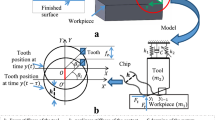Abstract
A new method for numerically controlled (NC)-simulation-based numerical analysis of the tool-workpiece contact area in cutting processes is presented. To gain enhanced knowledge about tool-workpiece interaction, determination of chip thickness, contact length, and resulting cross-section area of the undeformed chip is of major interest. Compared to common simulation approaches, where rotationally symmetrically constructed tool shape is used, the new method uses a detailed three-dimensional tool shape model for an extended and more accurate contact zone analysis. As a corresponding representation of the workpiece and its time-dependent change of shape, a multidexel model is used. To perform contact zone analysis, each cutting element and a multidexel model are intersected in discrete time steps corresponding to the tool rotation. Subsequently, the intersection point of each dexel is mapped on the local coordinate system of the cutting geometry. The parametric cutting geometry allows a direct computation of local cutting depth and contact length for each involved point. Based on the local values of contact length and cross section area of the undeformed chip, the characteristic values for the entire contact zone are calculated and used to predict mechanical loads caused by the cutting process. To demonstrate the application of the novel approach, a prediction of forces in slot milling and drilling of 1.1191 steel (C45EN) is presented.
Similar content being viewed by others
References
van Hook T (1986) Real-time shaded NC milling display. ACM SIGGRAPH Comput Graph 20(4):15–20
Benouamer MO, Michelucci D (1997) Bridging the gap between CSG and Brep via a triple ray representation, SMA’97: Proceedings of the fourth ACM symposium on Solid modeling and applications, ACM, p. 68–79
Gradisek J, Kalveram M, Weinert K (2004) Mechanistic identification of specific force coefficients for a general end mill. Int J Mach Tools Manuf 44:401–414
Müller H, Surmann T, Stautner M, Albersmann F, Weinert K (2003) Online sculpting and visualization of multi-dexel volumes, SM’03: Proceedings of the eighth ACM symposium on Solid modeling and applications, New York
Weinert K, Surmann T, Damm P (2004) Experiments in Adaptive Model-Based Force Control, Production Engineering, 11/2, p. 135.138
Roth D, Gray P, Ismail F, Bedi S (2007) Mechanistic modelling of 5-axis milling using an adaptive and local depth buffer. Comput Aided Des 39:302–312
Fussell BK, Jerard RB, Hemmett JG (2003) Modeling of cutting geometry and forces for 5-axis sculptured surface machining. Comput Aided Des 35:333–346
Yang Y, Zhang W, Wan M, Ma Y (2013) A solid trimming method to extract cutter-workpiece engagement maps for multi-axis milling. Int J Adv Manuf Technol 68:2801–2813
Aras E (2008) Cutter-workpiece engagement identification in multi-axis milling, PhD. Thesis, Faculty of Graduate Studies (Mechanical Engineering), University of British Columbia
Denkena B, Tracht K, Schmidt C (2006) A flexible force model for predicting cutting forces in end milling, Production Engineering, XIII/2, p. 15–20
Wan M, Lu M-S, Zhang W-H, Yang Y (2012) A new ternary-mechanism model for the prediction of cutting forces in flat end milling. Int J Mach Tools Manuf 57:34–45
Altintas Y (2000) Manufacturing automation: metal cutting mechanics, machine tool vibrations and CNC design, Cambridge University Press
Tunc LT, Budak E (2009) Extraction of 5-axis milling conditions from CAM data for process simulation. Int J Adv Manuf Technol 43:538–550
Denkena B, Schmidt A, Henjes J, Niederwestberg D, Niebuhr C (2013) Modeling a thermomechanical NC-simulation. Procedia CIRP 8:69–74
Author information
Authors and Affiliations
Corresponding author
Rights and permissions
About this article
Cite this article
Böß, V., Niederwestberg, D., Ammermann, C. et al. Cutting edge orthogonal contact-zone analysis using detailed tool shape representation. Int J Adv Manuf Technol 75, 1641–1650 (2014). https://doi.org/10.1007/s00170-014-6230-8
Received:
Accepted:
Published:
Issue Date:
DOI: https://doi.org/10.1007/s00170-014-6230-8




